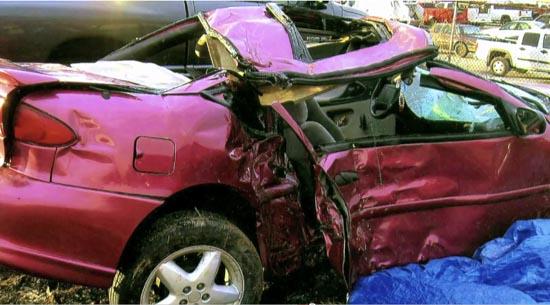
Texting while driving is a bad idea, and we've seen states and organizations create videos and laws to drive that home. AT&T does their part to get people to stop texting and driving with their "Txting and driving...It can wait" campaign, but today the carrier took things a step further. AT&T has announced the release of a short documentary that shows the dangers of trying to type on your handset while behind the wheel. You can watch the 10-minute video below for free, and the press release is below that.
We all know that trying to text and drive at the same time is a poor decision, but sometimes people can forget that with the excitement of the holidays and the New Year. The video may be a bit much at times, but it does its job of driving the point home. Remember, folks: no message you can send is worth risking your life and the lives of others. Be safe!
As New Year's Eve Approaches, AT&T Aims to Reach Millions with Powerful Anti-Texting While Driving Message
AT&T Distributing Free Documentary Featuring Families Affected by Texting Behind the Wheel to Educators, Government Officials, Safety Organizations and Public
“Where u at.” Those three words made up the last text message Mariah West read before her car crashed into a bridge, ending her life. Approaching one of the most dangerous days on the road – New Year’s Eve – AT&T* today announced the release of a powerful new documentary featuring stories from individuals, including Mariah’s parents, whose lives have been altered by texting while driving.
The 10-minute piece will be distributed nationwide to schools, safety organizations, government agencies and more as part of AT&T’s “It Can Wait” campaign. Each of the eight individuals included in the full-length reel volunteered their stories to help AT&T educate wireless customers – particularly youth – on the risks of tapping away on their cell phones in the car. The documentary can be viewed online at no charge on AT&T’s “It Can Wait” website and on AT&T’s YouTube page.
“Distracted driving is an epidemic, particularly among teens who are confident in their ability to text or talk while driving,” said U.S. Transportation Secretary Ray LaHood. “Of the 5,500 people killed last year due to distracted driving, the largest proportion of fatalities occurred among young people under the age of 20. I hope teens will take this powerful video to heart and realize that when you’re behind the wheel, no text message or phone call is worth the risk.”
“This documentary is a raw look at the reality and hazards of texting while driving, and we hope it will make wireless customers think twice before pulling out their cell phones in the driver’s seat,” said Cathy Coughlin, senior executive vice president and global marketing officer for AT&T. “As a global telecommunications company, it is our responsibility to bring these risks to light, especially now during the holiday season and as we approach New Year’s Eve.”
The documentary is supported by CTIA – The Wireless Association, The National Safety Council (NSC), National Organizations for Youth Safety (NOYS) and Family, Career and Community Leaders of America (FCCLA).
AT&T is working to distribute the video to numerous government agencies and safety organizations around the country, as well as to educators, students and policymakers to put real faces to the growing problem and spread the message.
It will also appear on the websites and communication channels such as newsletters and social media pages of NOYS (http://noys.org/), along with tens of thousands of schools affiliated with the organization.
In addition, AT&T will share the documentary with its wireless customers, employees and families through:
AT&T’s Teen Advisory Council – 10 teens of AT&T employees from across the country – and their schools;
AT&T U-verse® Mobile, AT&T U-verse Online and AT&T U-verse TV On Demand (airing continuously beginning this week on a dedicated channel at no cost to subscribers);
The AT&T employee “Defensive Driving” courses required for all company employees who drive as part of their job;
AT&T’s Smart ControlsSM page (www.att.com/smartcontrols), an all-in-one destination with information and tools for parents and children on how to stay safe with technology, and tips to manage content, spending, time and location;
AT&T’s “It Can Wait” resource center (www.att.com/txtngcanwait) and www.att.com multimedia download center; and
AT&T’s Friends & Family page (http://itcanwait.att.com/)
AT&T’s “It Can Wait” campaign launched in March 2010, and to date, more than 21,600 consumers have taken the pledge not to text and drive on AT&T’s Facebook page, in addition to more than 16,700 AT&T employees through its internal social media channel. More than 10,000 pledges have also been made on the AT&T Friends & Family page – an employee-led initiative encouraging others to commit to the cause.
AT&T continues to raise awareness about the issue of texting and driving through a multifaceted initiative. The campaign spans print, radio, TV and online advertising, in-store signage, collateral and online billing. In addition, parents, high school educators and, most importantly, youth, can visit AT&T’s online resource center. The site includes downloadable information about texting while driving such as a parent-teen pledge, a teen-teen pledge, a poster, a brochure, safety tips and more.
Since 2009, the company has revised its wireless and motor vehicle policies to more clearly and explicitly prohibit texting and driving, impacting its more than 265,000 employees; incorporated a don’t-text-and-drive message on the plastic clings that protect handset screens on the majority of new devices sold in AT&T’s more than company-owned 2,200 stores; and has integrated campaign messaging in AT&T catalogs, in-store signage and collateral, bills, e-mails, newsletters and more.
As one of the nation's leading employers and with one of the largest commercial fleets, AT&T has also incorporated a section on the hazards of texting and driving in its defensive driving classes, which all employees who drive as part of their job are required to take.
For additional information on AT&T’s “It Can Wait” campaign, please visit www.att.com/txtingcanwait.